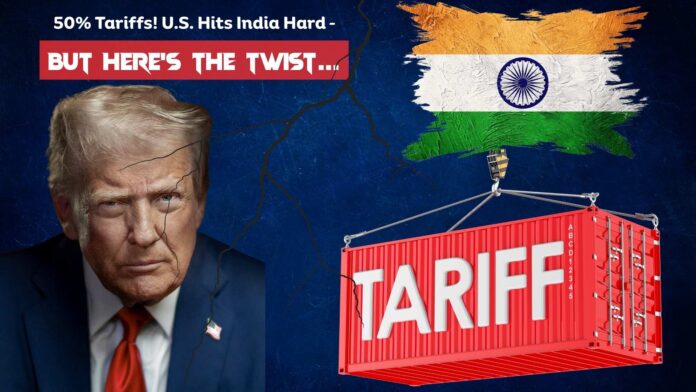The trade relationship between the United States and India has entered one of its most challenging phases in recent years. In a move that has caught global markets’ attention, the U.S. government has announced a 50% tariff on a range of Indian goods, a significant escalation in the ongoing trade tensions between the two nations.
This new tariff, scheduled to take effect from August 27, 2025, combines an additional 25% duty with an earlier 25% levy, effectively doubling the import tax on targeted products. The decision comes amid growing disagreements over India’s continued purchase of Russian oil—a move the U.S. says undermines efforts to curb Russia’s war operations.
What are Tariffs?
Tariffs are basically taxes that a government puts on goods coming in from other countries.
If an Indian shirt costs $10 to export, and the U.S. has a 50% tariff, the importer pays $5 extra in tax. The shirt now costs $15 before any shop profit, meaning higher prices for buyers.
It’s like a customs toll that countries charge to control trade and influence politics.
The Core Reason Behind the Tariffs
While Washington has long been critical of countries trading with Russia amid the Ukraine conflict, India’s steadfast oil imports have drawn special focus. According to U.S. President Donald Trump, India’s energy relationship with Russia is “fueling the war machine,” and the tariffs are intended as a punitive measure.
However, New Delhi has called the move “selective and unfair”, pointing to the fact that several other nations also maintain trade ties with Russia but have not faced similar treatment. The Indian government has signaled that it is willing to “pay a heavy price” to protect its strategic and economic interests, especially in agriculture and energy security.
Which Products Will Be Affected?
The 50% tariff will hit a broad range of Indian exports to the U.S., especially in sectors where India holds a competitive advantage:
- Textiles and Apparel
- Gems and Jewellery
- Leather Goods
- Shrimp and Seafood
- Chemicals
- Certain Auto Components
On the other hand, some major sectors remain exempt, such as:
- Pharmaceuticals (a critical supply chain for U.S. healthcare)
- Smartphones and Consumer Electronics
- Renewable Energy Equipment
- Energy Exports
This mixed approach indicates that while Washington is sending a strong political message, it is also protecting areas where U.S. industries depend heavily on Indian supplies.
The Economic Impact on India
The financial consequences for India could be significant. Exporters—especially MSMEs—are expected to bear the brunt, as the U.S. accounts for a substantial share of their overseas sales. Industry bodies estimate that over 55% of India’s shipments to the U.S. will be directly affected.
Economic analysts have also weighed in:
- Moody’s predicts that the tariffs could shave 0.3 percentage points off India’s GDP growth in FY26.
- Morgan Stanley warns of an even bigger impact, possibly reducing growth by 80 basis points over the next year.
Beyond the numbers, there is the risk of lost market share. If Indian products become too expensive for American buyers, competitors like Vietnam, Bangladesh, and Mexico may step in to fill the gap.
The Cost for American Consumers
Tariffs are not a one-way pain. U.S. consumers will likely face higher prices for goods such as clothing, footwear, seafood, and certain auto parts. Estimates suggest that the average American household could see an annual cost increase of around $2,400, adding to inflationary pressures in an already sensitive economic climate.
What Does the U.S. Import from Russia?
Here’s where the debate gets more complicated. The U.S. stopped importing Russian oil, LNG, and coal in March 2022 following the invasion of Ukraine. However, Washington still imports billions of dollars worth of other goods from Russia each year—largely due to strategic dependencies.
Major U.S. imports from Russia include:
- Fertilizers (critical for U.S. agriculture)
- Palladium (used in electronics, automotive, and industrial applications)
- Enriched Uranium (for civilian nuclear power plants)
Between January and May 2025, U.S. imports from Russia rose to around $2.1 billion, with notable increases in palladium (+37%), uranium (+28%), and fertilizers (+21%). These are sectors where alternatives are limited, but the trade flows still represent revenue for Moscow.
The Broader Strategic Implications
This episode comes at a time when India has been aggressively pushing its “Make in India” and export-led growth strategy. Moody’s warns that the tariffs could derail these ambitions by weakening India’s manufacturing competitiveness in one of its largest markets.
At the same time, global investors are watching closely. India’s stock markets have already seen capital outflows amid uncertainty, and the rupee has come under pressure against the dollar.
Conclusion: A Question for the Audience
The U.S. has justified its tariffs on India by accusing New Delhi of funding Russia’s war through oil purchases. Yet, the U.S. itself continues to import key Russian products such as fertilizers, palladium, and enriched uranium—trades worth billions of dollars annually.
This raises an important question:
If U.S. imports from Russia continue, does this not also contribute—directly or indirectly—to fueling the conflict in Ukraine?
What do you think? Share your views in the comments below.
Previous Blog: How New UPI Rules Are Changing the Way India Pays: A Deep Dive into NPCI’s August 2025 Update

